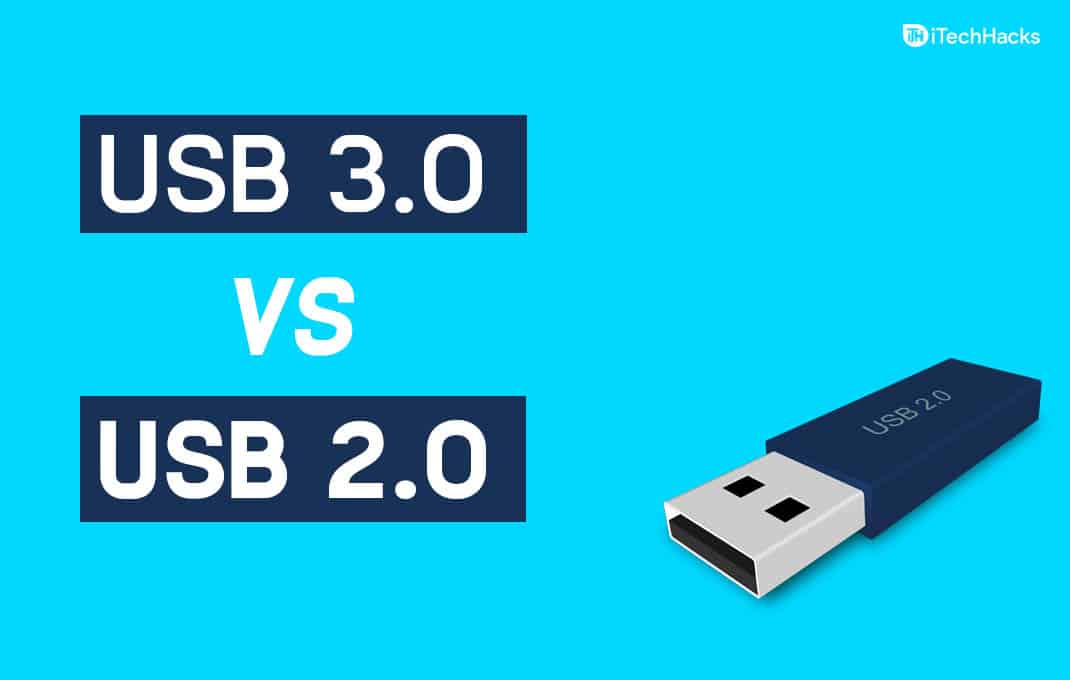- USB 2.0 was released in 2000, while USB 3.0 came out in 2008, gradually replacing the former.
- USB 3.0 offers faster transfer speeds, up to 4.8 Gbps compared to 480 Mbps for USB 2.0.
- USB 3.0 connectors are physically larger, have more wires, provide more power, and have better bandwidth compared to USB 2.0.
USB is an abbreviation for Universal Serial Bus. It is an interface that is used to connect peripheral devices such as your mouse, keyboard, printer, hard drives, to your computer.
USB 2.0 was released in the year 2000 and it is the most widely used USB version to date. USB 3.0 was released in the year 2008 and it is gradually taking over.
USB 2.0 and USB 3.0 have their unique set of features. Thus, here we are with all the differences between USB 2.0 and USB 3.0.
ALSO READ: Difference Between Invoice and Quote
Differences between USB 2.0 and USB 3.0
 1. Physical Appearance.
1. Physical Appearance.
USB 2.0 Connectors are black on the inside, while the USB 3.0 is blue on the inside.
USB 2.0 has 4 connector wires, while USB 3.0 has 9 connector wires.
Thus, USB 3.0 connectors are larger than the USB 2.0 connector. It is such, to accommodate the additional wires. Thus, USB 3.0 connectors cannot be used with USB 2.0 ports.
2. Transfer Speed.
USB 2.0 transfer speed is 480 Mbps, while USB 3.0 transfer speed is 4.8 Gbps. Thus, USB 3.0 is 10 times faster than USB 2.0.
3. Backward Compatibility.
USB 3.0 ports are backward compatible. Thus, a USB 2.0 device can be connected to a USB 3.0 port. However, when a USB 3.0 device is connected to a USB 2.0 port, the data transfer speeds will be limited to USB 2.0 speed, which is about 480 Mbps.
4. Power Management.
USB 2.0 provides power up to 500 mA to its devices, whereas USB 3.0 provides up to 900 mA of power. This results in an increase of total power delivery from 2.5 W to 4.5 W, at 5 V.
Thus, USB 3.0 devices can be charged faster when connected to USB 3.0 ports. Also, USB 3.0 provides efficient power management and increases power delivery. It can also conserve power by cutting off supply to idle devices.
5. Bandwidth.
USB 2.0 is a one-way communication, this means the data is sent and received over the same pathway. Thus, USB 2.0 can only send data or receive data at a given time, but not both.
USB 2.0 is a one-way communication, this means that it uses two separate unidirectional data paths. One for sending data and the other for receiving data.
Thus, USB 3.0 has a larger bandwidth than USB 2.0.
6. USB Cables.
USB 3.0 cables can be used to connect to USB 2.0 ports and vice versa. But, USB 3.0 devices require 3.0 cables only. Thus, it is important that you match the USB cable with the USB port version.
Also, USB 2.0 cables can be up to 5 meters long whereas USB 3.0 cables are only up to 3 meters long.
7. Price.
The USB 2.0 devices are considerably cheaper than the USB 3.0 devices. This is due to the advanced features provided by USB 3.0, which are missing in USB 2.0. However, USB 3.0 devices provide value for the money.
Types of USB
| USB 1.0 | Supports up to 127 peripheral devices with a data transfer rate of 12 Mbps. |
| USB 2.0 | It was first introduced in 2000 and is known as high-speed USB. It supports USB 1 devices and cables. |
| USB 3.0 | SuperSpeed USB is an improved version of USB 2 that was first introduced in 2008. |
| USB 3.1 | The latest version of USB, known as SuperSpeed+, was first introduced in 2014. |
| USB Type-C | Is a 24-pin reversible plug that was introduced around the same time as USB 3.1. |
Also Read: Difference Between FAT32 vs NTFS vs exFAT File Systems?
Conclusion:
These are a few notable differences between USB 2.0 and USB 3.0. As we have mentioned above, the features possessed by USB 3.0 are superior to the features of USB 2.0. Thus, it is recommended that you choose USB 3.0 over USB 2.0.
Also, USB 3.0 is backward compatible and thus, you do not have to use any special tool for connecting a USB 2.0 device to a USB 3.0 port, and vice versa. If you have any queries regarding the difference between USB 2.0 and USB 3.0, then do let us know about it in the comments section below.



